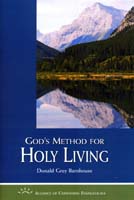Jesus set forth the plan with the Great Commission in Mark 16:15-16. The gospel is Christ’s message, brought by Christ’s people, in Christ’s power. It calls the disciple to a life of complete surrender and total engagement. It is the life Jesus spoke of in Mark 8:34-35.

Mary’s frame of mind – so far removed from anticipating the resurrection – is precious proof of the historic reality of the resurrection. In the mind of Mary there was no soil in which hallucinations would spring - psychologically, it is absurd to say that she could have suddenly imagined the risen Christ. Mary’s love needed more than an empty grave and waiting angels to stay her tears.

Why did Jesus die? That is the question we need to answer as we read of Jesus’ suffering and death. Christ died because it was the purpose for which He had come to the earth. He died because His death would resolve the great dilemma of God. And He died because His kingdom of righteousness could not come without sacrifice. It was by the death of Jesus that the great tension within God Himself could be resolved. God has just as much hatred for my sin as he has love for my soul, but how can God strike my sin without destroying me? The answer is in Jesus who came so God could take my sin and put it on another. Then, with my sin on the Savior, God could strike the sin without striking me.

Here in Mark 12, Christ calls Himself the measuring stone, or as it is translated in our Bible, “the cornerstone.” When the Bible refers to the cornerstone, it refers to the first stone laid in the foundation. The builders would get a stone from the quarry and chisel it carefully to get as near a right angle as possible. They would measure the placement of all other stones against that cornerstone. It was the standard by which all the walls of the building were measured.

Lesson from a fig Tree
“May no one ever eat fruit from you again.” (Mark 11:14)
I was brought up in California with a fig tree in my backyard. It was typical to find fresh figs in July and August, perhaps a few in September, and than, when the leaves fell off, to find dry figs in October and November, still on the tree. It was perfectly possible and plausible for Jesus to look for some dried figs, still on the tree from the season past, amid the first green leaves of the new crop to come. There is nothing ridiculous about Jesus’ response. The only problem is to find out the significance of His response.
In Jeremiah 8:13, God speaks about coming to Israel expecting to find righteousness, saying, “When I would gather them, declares the LORD, there are no grapes on the vine, nor figs on the fig tree; even the leaves are withered, and what I gave them has passed away from them.” On this morning, Jesus sees the fig tree and kills two errors with one parable. Here was the fig tree-leaves – leaves, and no figs! A perfect picture of the nation of Israel. They had religion coming out their ears. The religious leaders had plenty of leaves. Their religion was all leaves, but no fruit,
Meditation: Is my Christian walk all “leaves“?
Further Reading: Matthew 11:12-14; 20-26





















